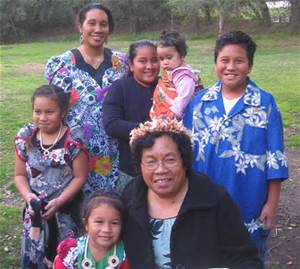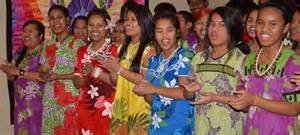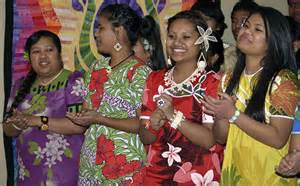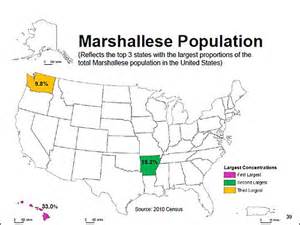Encyclopedia Dubuque
"Encyclopedia Dubuque is the online authority for all things Dubuque, written by the people who know the city best.”
Marshall Cohen—researcher and producer, CNN
Affiliated with the Local History Network of the State Historical Society of Iowa, and the Iowa Museum Association.
MARSHALLESE
MARSHALLESE. The Marshall Islands were named for British Captain William Marshall, who explored the area with Captain Thomas Gilbert in 1788. The atolls were not united until Europeans named and mapped them, Rālik-Ratak, the Marshallese designation for the leeward and windward chains of atolls, was considered an official name at the time of independence. (1)
Whalers from Europe and the United States were originally attracted to the Marshall Islands in the 1830s to 1850s but by the 1860s copra (the production of dried coconut) became Europeans' main interest in the islands. Under Japanese control (between WORLD WAR I and [[WORLD WAR II) copra production continued, in addition to a fishing industry (controlled by Okinawans), and by exports of phosphorus, coconut husk mats, and handicrafts. (2)
Following World War II, the United States had a strategic interest in the Marshall Islands with few attempts at development. As copra prices declined on the world market, Marshall Islanders relied more on the meager income from handicrafts to supplement the economy. By the 1960s and 1970s, financial assistance programs were begun to make up for United States neglect of the region and became the major source of income. Since independence, United States aid has been increased by programs from other Pacific Rim countries. (3)
Since World War II the capital of the Marshall Islands has been located on Majuro, in the southern part of the Ratak chain. With a very high rate of population increase, the Marshall Islands has changed rapidly from 43,380 people in 1988 to a projected population of well over 60,000 in 1999. Residents are very mobile, and nearly 80 percent are now urban. Approximately one-half of the population lives on Majuro Atoll. The other urban site is Ebeye (Epjā islet), Kwajalein Atoll, one of the world's most densely-populated locations, where many residents work on the United States military base on nearby Kwajalein islet. Other Marshall Islanders choose to live on one of two dozen inhabited outer atolls or coral pinnacles where a more traditional style of life can be maintained. (4)
All residents speak Marshallese, an Austronesian language that shares many similarities with other Pacific languages. Marshallese dialects began to disappear after missionaries from the American Board of Commissioners for Foreign Missions (ABCFM) arrived on Ebon, in the southern Ralik Chain, in 1857 and developed a writing system. At least three mutually dialects remain: Ratak, Rālik, and an Enewetak/Ujelang variant. Former eras of Spanish, German, Japanese, and American administration and intermarriage between Marshall Islanders and other Pacific Islanders mean that Marshall Islanders often learn multiple languages. Many residents understand and/or speak a pidgin English, which has become a lingua franca in the west-central Pacific. (5)
Beginning with the establishment of the Congress of Micronesia in 1965, local elites representing the various island groups that made up the Trust Territory of the Pacific Islands established the Micronesian Political Status Commission in 1967. This organization explored political choices for the future of the region. The range of options that were discussed with representatives of the United States included total independence, a status of free association with the United States, continuing status as a Trust Territory, and integration with the United States. (6)
Even though the original negotiations had expected a common future for the Trust Territory, the United States, based on its own interests in the region, soon began to negotiate separately with the Northern Mariana Islands. The United States Department of Defense also wished to maintain special rights of access and use in the Marshall Islands and Belau. On the basis of these strategic advantages, these two districts were granted separate opportunities to negotiate their political futures. The remaining districts of the Trust Territory, lacking in special resources or strategic value to the United States, were not granted equal status. (7)
The United States favored commonwealth status for the region in 1970, and in 1975 the Northern Mariana Islands voted to become a commonwealth of the United States. Prior to the formal establishment of the Commonwealth of the Northern Mariana Islands, however, the United States reconsidered its initial rejection of free association as an option. The Marshall Islands, Belau, and the remaining districts of the Trust Territory, now known as the Federated States of Micronesia, began to negotiate constitutional governments that would be linked to the United States by compacts of free association. Most elements of self-government were granted the Republic of the Marshall Islands in 1970, with formal statehood in free association with the United States decreed by the United States president in 1986. The Republic of the Marshall Islands became a member state of the United Nations in 1991. (8)
Since the 1960s, social welfare programs have been available, supported by the United States, various religious groups and, since independence, other Pacific Rim nations. United States social welfare programs for education, health and nutrition, and the needs of youth, women, and the aged are particularly well-known. Many residents rely on these programs, especially in urban areas. (9)
Without immigration restrictions, Marshallese and United States citizens can travel between the two countries to study work and live. There has been a Marshallese community in Dubuque since 1992. The majority of the group are employed, but at minimum-wage jobs due to their lack of English. In 1996 welfare reform made Marshallese migrants ineligible for federally funded benefits programs. In 2015 Pastor Stanley Samson hoped to work with medical providers and city leaders to provide them with local resources. Samson also organized a neighborhood picnic and concert in COMISKEY PARK to promote Marshallese customs and improve community ties. (10)
---
Source:
1. "Marshallese, Marshall Islander," Countries and Their Cultures. Online: http://www.everyculture.com/Ma-Ni/Marshall-Islands.html
2. Ibid.
3. Ibid.
4. Ibid.
5. Ibid.
6. Ibid.
7. Ibid.
8. Ibid.
9. Ibid.
10. Barton, Thomas J. "Pastor Unites Marshallese Community," Telegraph Herald, September 28, 2015, p. 3A





